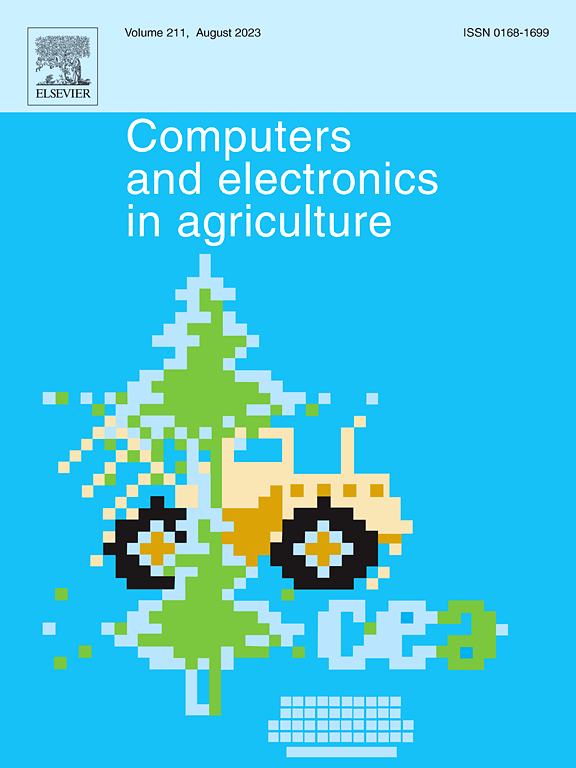Wheat3D PartNet: Annotated dataset for 3D wheat part segmentation
IF 8.9
1区 农林科学
Q1 AGRICULTURE, MULTIDISCIPLINARY
引用次数: 0
Abstract
High precision 3D data is becoming crucial for accurate feature extraction. Acquiring 3D data from plants with different growing patterns and thier growth under different environmental conditions is still a challenging task. The utilization of deep learning techniques can overcome some of these challenges, but these techniques often demand good quality training data for 3D point cloud analysis. One of the main challenges in plant phenotyping is the general lack of annotated 3D datasets available to the research community. Constructing such datasets is particularly difficult due to the complexity of capturing high-quality data that accurately represent the intricate structures and diverse morphologies of plants. The development of robust data sets is critical to advance plant phenotyping, allowing precise quantification of plant traits, and addressing challenges in modern agriculture. However, the lack of high-quality, annotated datasets for complex plant structures, such as wheat, hinders the development of effective methodologies. To address this, we introduce Wheat3D PartNet, a comprehensive repository of 1303 3D point cloud models of wheat (Triticum L.), comprising three cultivars: Paragon, Gladius, and Apogee. The 3D point clouds are reconstructed from RGB images of real plants that were acquired from multiple viewpoints and represent different plant structures at different growth rates. Wheat3D PartNet samples are manually labeled into two parts i.e., ears (wheat spikes) and non-ears (leaves and stems) and that captured in drought and watered conditions. Wheat3D PartNet is designed to support segmentation-based trait quantification tasks such as spike counting, spike length estimation, and stress detection—facilitating more precise yield prediction and enabling early agronomic intervention. Extensive experiments using several state-of-the-art 3D deep learning models validate the dataset’s utility and challenge level. The methodology behind Wheat3D PartNet is extensible to other crops, including rice and potato, and is expected to significantly boost the research, understanding, and measurements of plants of interest.
Wheat3D PartNet:用于小麦部分三维分割的标注数据集
高精度的三维数据对于准确提取特征变得至关重要。获取不同生长模式植物及其在不同环境条件下生长的三维数据仍然是一项具有挑战性的任务。利用深度学习技术可以克服其中的一些挑战,但这些技术通常需要高质量的3D点云分析训练数据。植物表型分析的主要挑战之一是普遍缺乏可用于研究界的注释3D数据集。构建这样的数据集是特别困难的,因为获取高质量数据的复杂性,准确地代表了植物复杂的结构和多样的形态。开发强大的数据集对于推进植物表型,实现植物性状的精确量化以及应对现代农业中的挑战至关重要。然而,缺乏针对复杂植物结构(如小麦)的高质量、带注释的数据集,阻碍了有效方法的发展。为了解决这个问题,我们引入了Wheat3D伙伴网,这是一个综合存储库,包含1303个小麦(Triticum L.)的3D点云模型,包括三个品种:Paragon、Gladius和Apogee。三维点云是由多个视点获取的真实植物的RGB图像重建而成,代表了不同生长速率下的不同植物结构。Wheat3D伙伴网样本被手工标记为两部分,即穗(小麦穗)和非穗(叶片和茎),并在干旱和浇水条件下捕获。Wheat3D合作伙伴网旨在支持基于片段的性状量化任务,如穗计数、穗长估计和应力检测,从而促进更精确的产量预测和早期农艺干预。使用几个最先进的3D深度学习模型的广泛实验验证了数据集的实用性和挑战性。Wheat3D合作伙伴网背后的方法可以扩展到其他作物,包括水稻和土豆,并有望显著促进对感兴趣的植物的研究、理解和测量。
本文章由计算机程序翻译,如有差异,请以英文原文为准。
求助全文
约1分钟内获得全文
求助全文
来源期刊

Computers and Electronics in Agriculture
工程技术-计算机:跨学科应用
CiteScore
15.30
自引率
14.50%
发文量
800
审稿时长
62 days
期刊介绍:
Computers and Electronics in Agriculture provides international coverage of advancements in computer hardware, software, electronic instrumentation, and control systems applied to agricultural challenges. Encompassing agronomy, horticulture, forestry, aquaculture, and animal farming, the journal publishes original papers, reviews, and applications notes. It explores the use of computers and electronics in plant or animal agricultural production, covering topics like agricultural soils, water, pests, controlled environments, and waste. The scope extends to on-farm post-harvest operations and relevant technologies, including artificial intelligence, sensors, machine vision, robotics, networking, and simulation modeling. Its companion journal, Smart Agricultural Technology, continues the focus on smart applications in production agriculture.
 求助内容:
求助内容: 应助结果提醒方式:
应助结果提醒方式:


